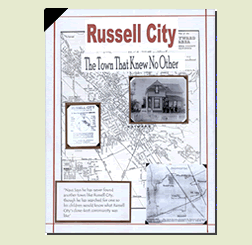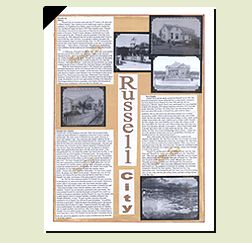





History
Russell City was founded in the early nineteenth century with about ten to fifteen families. These families lived in small houses made by a Danish craftsman. An Englishman from Maine, named Joel Russell, founded the City. Joel Russell bought the land in 1850 from a Spanish grant. "Russell was a lawyer who served for many years as Hayward city attorney and justice of the peace" (South Country Almanac). Joel Russell was a well-known man in his time.
During this time, the population of the Bay Area was small. The 1906 earthquake had left its mark and people didn't want to move to the Bay Area. However, in an attempt to attract consumers, real estate companies began to promote the Bay Area. In an article from the Oakland Tribune it was stated "In 1907 such promoters sold the heirs of the Pestdorf and Russell families on the idea of combining their lands." These two landholdings combined, made up one thousand acres and was called Russell City.
A 1908 poster of Russell City tells its story. That year, seven hundred lots were sold for fifty to three hundred dollars a lot. There was a folder at the Hayward Historical Society that showed how they expected the city to develop. A quote on the poster states, "Russell City is going to be the largest city on San Francisco Bay. We have a better location for a city than San Francisco, Oakland, or Berkeley." At this time the Russell family was trying to attract people to come to Russell City from San Francisco and Oakland.
When the Great Depression came in 1929, a lot of people left Russell City and many of the homes were sold. Russell City lots became even cheaper. At this time many Mexican families came from Los Angeles County because it was a lot cheaper to buy a lot in Russell City. Others came from rural areas, including Oklahomans who came from the Dustbowl. During World War II, blacks came from the South to escape discrimination and for work opportunities in the shipyards. This change created a diverse community, where Latinos and all people of different races could interact with each other in a friendly way.
Nava Family
Ernesto Nava and his family moved into Russell City in 1945. Mr. Nava had constructed a house in Russell City so his family could grow. The Nava family lived in Russell City from 1945 until the city was destroyed in 1964. Ernesto Nava's son said Russell City was comprised of about forty-five percent Mexican, forty-five percent black, and about ten percent Caucasian people. His father, Nava says, said that during that time there were about six hundred people in Russell City, quite small by today's standards.
Ernesto's son, Sam Nava, says that almost nobody went to school because they couldn't afford it and because they had to take care of their families. He also says there weren't any junior colleges, so they couldn't go to college. Some people who really wanted to go to college couldn't because the only colleges close were Stanford, Cal, or other elite colleges, which they could not afford.
Sam Nava said "Most of them there didn't have too much of an education, basically, if you made it ... none of them hardly made it through high school, later on it changed, maybe into the late 50s, early 60s, now they were at least finishing high school ... college was out of the question, because there was no JC [junior college] around here. One thing was Standford and Cal, who had that kind of loot?!"
Many of the people who lived in Russell City worked in the canneries and shipyards. Sam Nava says that a lot of people were hired at Hunt's cannery in Oakland and in Hayward. According to Sam Nava, if you were lucky you could work at General Motors. There were a lot of agricultural areas in the Bay Area at the time. Women also contributed in the work efforts in Russell City to support their families. Women were fortunate to work in the canneries.
Russell City and Hayward were two different towns. Sam Nava said "Russell City was so close to Hayward yet so far." He said, "They were not segregated in any way, no. Basically once you crossed those railroad tracks that's mainly the main part of Russell City." Sam Nava sees Hayward and Russell City as two totally different cities. He says "basically growing up in a little town, like Russell City, Hayward was always like Hollywood!"
continue-->

